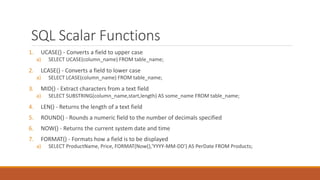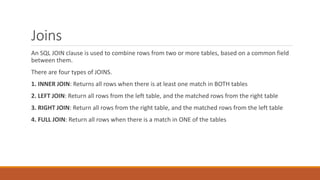SQL Queries Information
- 1. SQL (Structured Query Language) A LANGUAGE OF DATABASE
- 2. SQL Overview SQL is a programming language for Relational Databases. It is designed over relational algebra and tuple relational calculus. SQL comes as a package with all major distributions of RDBMS. SQL comprises both data definition and data manipulation languages. Using the data definition properties of SQL, one can design and modify database schema, whereas data manipulation properties allows SQL to store and retrieve data from database.
- 3. Characteristics of SQL SQL allows the user to create, update, delete, and retrieve data from a database. * SQL is very simple and easy to learn. * SQL works with database programs like DB2, Oracle, MS Access, Sybase, MS SQL Sever etc.
- 4. Advantages of SQL • High Speed: SQL Queries can be used to retrieve large amounts of records from a database quickly and efficiently. • Well Defined Standards Exist: SQL databases use long-established standard, which is being adopted by ANSI & ISO. Non-SQL databases do not adhere to any clear standard. • No Coding Required: Using standard SQL it is easier to manage database systems without having to write substantial amount of code. •Emergence of ORDBMS: Previously SQL databases were synonymous with relational database. With the emergence of Object Oriented DBMS, object storage capabilities are extended to relational databases.
- 5. Disadvantages of SQL • Difficulty in Interfacing: Interfacing an SQL database is more complex than adding a few lines of code. • More Features Implemented in Proprietary way: Although SQL databases conform to ANSI & ISO standards, some databases go for proprietary extensions to standard SQL to ensure vendor lock-in.
- 6. SQL Data Types 1. BIGINT Data Type 2. BOOLEAN Data Type 3. CHAR Data Type 4. DECIMAL Data Type 5. DOUBLE Data Type 6. FLOAT Data Type 7. INT Data Type 8. SMALLINT Data Type 9. STRING Data Type 10. TIMESTAMP Data Type 11. TINYINT Data Type 12. VARCHAR Data Type
- 7. SQL Literals The terms literal and constant value are synonymous and refer to a fixed data value 1. Numeric Literals 2. String Literals: String needs to be in single quotes 3. Boolean Literals: TRUE or FALSE 4. Timestamp Literals 5. NULL
- 8. String Literals Use the text literal notation to specify values whenever 'string' or appears in the syntax of expressions, conditions, SQL functions, and SQL statements in other parts of this reference 'Hello' 'ORACLE.dbs‘ q'!name LIKE '%DBMS_%%'!' q'<'So,' she said, 'It's finished.'>‘ Numeric Literals You must use the integer notation to specify an integer whenever integer appears in expressions, conditions, SQL functions, and SQL statements described in other parts of this reference. 25 +6.34 0.5 25e-03 -1 25f +6.34F 0.5d -1D
- 9. Date Time Literals You can specify a DATE value as a string literal, or you can convert a character or numeric value to a date value with the TO_DATE function. DATE literals are the only case in which Oracle Database accepts a TO_DATE expression in place of a string literal. To specify a DATE value as a literal, you must use the Gregorian calendar. You can specify an ANSI literal, as shown in this example: DATE '1998-12-25‘ TO_DATE('98-DEC-25 17:30','YY-MON-DD HH24:MI') Timestamp Literals TIMESTAMP '1997-01-31 09:26:56.66 +02:00‘ TIMESTAMP '1999-04-15 8:00:00 US/Pacific‘ (with Zone)
- 10. Types of SQL Commands 1. Data Definition Language 2. Data Manipulation Language
- 11. Data Definition Language(DDL) CREATE Creates new databases, tables and views from RDBMS. Create database tutorialspoint; Create table article; Create view for_students; DROP Drops commands, views, tables, and databases from RDBMS. Drop object_type object_name; Drop database tutorialspoint; Drop table article; Drop view for_students; ALTER Modifies database schema. This command adds an attribute in the relation article with the name subject of string type. Alter table article add subject varchar;
- 12. Data Manipulation Language(DML) SQL is equipped with data manipulation language (DML). DML modifies the database instance by inserting, updating and deleting its data. DML is responsible for all froms data modification in a database. SQL contains the following set of commands in its DML section − 1. SELECT/FROM/WHERE 2. INSERT INTO/VALUES 3. UPDATE/SET/WHERE 4. DELETE FROM/WHERE These basic constructs allow database programmers and users to enter data and information into the database and retrieve efficiently using a number of filter options. Select author_name From book_author Where age > 50; INSERT INTO table (column1 [, column2, column3 ... ]) VALUES (value1 [, value2, value3 ... ]) UPDATE table_name SET column_name = value [, column_name = value ...] [WHERE condition] DELETE FROM table_name [WHERE condition];
- 13. Tables A relational database system contains one or more objects called tables. The data or information for the database are stored in these tables. Tables are uniquely identified by their names and are comprised of columns and rows. Columns contain the column name, data type, and any other attributes for the column. Rows contain the records or data for the columns. Here is a sample table called "weather". city, state, high, and low are the columns. The rows contain the data for this table: Weather city state high low Phoenix Arizona 105 90 Tucson Arizona 101 92 Flagstaff Arizona 88 69 San Diego California 77 60 Albuquerque New Mexico 80 72
- 14. Creating Table CREATE TABLE table_name ( column_name1 data_type(size), column_name2 data_type(size), column_name3 data_type(size), .... ); CREATE TABLE Persons ( PersonID int, LastName varchar(255), FirstName varchar(255), Address varchar(255), City varchar(255) ); Syntax Example PersonID LastName FirstName Address City
- 15. Insert into Table INSERT INTO table_name (column1,column2,column3,...) VALUES (value1,value2,value3,...); INSERT INTO persons(PersonID,LastName,FirstName,Address,City) VALUES(1011,’Mehta’,’Kunal’,’myaddress’,’Haridwar’); CREATE TABLE persons ( PersonID int, LastName varchar(255), FirstName varchar(255), Address varchar(255), City varchar(255) ); PersonID LastName FirstName Address City 1011 Mehta Kunal Myaddress Haridwar
- 16. SELECT STATEMENT • SELECT column_name,column_name FROM table_name; • SELECT * FROM table_name; CustomerID CustomerName ContactName Address City PostalCode Country 1 HARI Maria Anders Obere Str. 57 Berlin 12209 Germany 2 RAM Ana Trujillo Avda. de la Constitución 2222 México D.F. 05021 Mexico 3 SHYAM Antonio Moreno Mataderos 2312 México D.F. 05023 Mexico
- 17. SELECT DISTINCT • In a table, a column may contain many duplicate values; and sometimes you only want to list the different (distinct) values. • The DISTINCT keyword can be used to return only distinct (different) values. CustomerID CustomerName ContactName Address City PostalCode Country 1 HARI Maria Anders Obere Str. 57 Berlin 12209 Germany 2 RAM Ana Trujillo Avda. de la Constitución 2222 México D.F. 05021 Mexico 3 SHYAM Antonio Moreno Mataderos 2312 México D.F. 05023 Mexico SELECT DISTINCT column_name,column_name FROM table_name;
- 18. WHERE Clause The WHERE clause is used to extract only those records that fulfill a specified criterion. SELECT column_name,column_name FROM table_name WHERE column_name operator value; SELECT * FROM Customers WHERE Country='Mexico'; CustomerID CustomerName City Country 1 HARI Berlin Germany 2 RAM México D.F. Mexico 3 SHYAM México D.F. Mexico
- 19. AND & OR Clause The AND operator displays a record if both the first condition AND the second condition are true. The OR operator displays a record if either the first condition OR the second condition is true. CustomerID CustomerName City Country 1 HARI Berlin Germany 2 RAM México D.F. Mexico 3 SHYAM México D.F. Mexico SELECT * FROM Customers WHERE Country='Germany' AND City='Berlin'; SELECT * FROM Customers WHERE City='México D.F.' OR City='München'; SELECT * FROM Customers WHERE Country='Germany' AND (City='Berlin' OR City='München');
- 20. DELETE STATEMENT DELETE FROM table_name WHERE some_column=some_value; CustomerID CustomerName City PostalCode Country 1 HARI Berlin 12209 Germany 2 RAM México D.F. 05021 Mexico 3 SHYAM México D.F. 05023 Mexico DELETE FROM Customers WHERE CustomerName=‘Hari’ AND City=‘Berlin'; DELETE FROM Customers WHERE CustomerName=‘Ram’ AND Country=‘Germany';
- 21. UPDATE UPDATE table_name SET column1=value1,column2=value2,... WHERE some_column=some_value; CustomerID CustomerName City PostalCode Country 1 HARI Berlin 12209 Germany 2 RAM México D.F. 05021 Mexico 3 SHYAM México D.F. 05021 Mexico
- 22. CustomerID CustomerName City PostalCode Country 1 HARI Berlin 12209 Germany 2 RAM México D.F. 05021 Mexico 3 SHYAM Hamburg 05021 Germany UPDATE Customers SET City=‘Hamburg’, COUNTRY=‘GERMANY’ WHERE CustomerName=‘SHYAM’; CustomerID CustomerName City PostalCode Country 1 HARI Hamburg 12209 Germany 2 RAM Hamburg 05021 Germany 3 SHYAM Hamburg 05021 Germany UPDATE Customers SET City=‘Hamburg', City=‘Germany';
- 23. ORDER BY Clause The ORDER BY keyword is used to sort the result-set by one or more columns. The ORDER BY keyword sorts the records in ascending order by default. To sort the records in a descending order, you can use the DESC keyword. SELECT column_name, column_name FROM table_name ORDER BY column_name ASC|DESC; SELECT * FROM Customers ORDER BY Country; CustomerID CustomerName City Country 1 HARI Berlin Germany 2 RAM México D.F. Mexico 3 SHYAM México D.F. Mexico SELECT * FROM Customers ORDER BY Country DESC;
- 24. DROP & TRUNCATE DROP TABLE table_name DROP DATABASE database_name TRUNCATE TABLE table_name
- 25. ALTER TABLE STATEMENT ALTER TABLE table_name ADD column_name datatype ALTER TABLE table_name DROP COLUMN column_name P_Id FirstName Address City 1 Ola Timoteivn 10 Sandnes 2 Tove Borgvn 23 Sandnes 3 Kari Storgt 20 Stavanger ALTER TABLE Persons ADD DOB date P_Id FirstName Address City DOB 1 Ola Timoteivn 10 Sandnes 2 Tove Borgvn 23 Sandnes 3 Kari Storgt 20 Stavange r ALTER TABLE Persons ALTER COLUMN DOB year
- 26. Creating Views Syntax: CREATE VIEW view_name AS SELECT column_name(s) FROM table_name WHERE condition Example: CREATE VIEW [Current Product List] AS SELECT ProductID,ProductName FROM Products WHERE Discontinued=No Query from View: SELECT * FROM [Current Product List]
- 27. Updating Views Syntax: CREATE OR REPLACE VIEW view_name AS SELECT column_name(s) FROM table_name WHERE condition Example: CREATE OR REPLACE VIEW [Current Product List] AS SELECT ProductID,ProductName,Category FROM Products WHERE Discontinued=No
- 28. Aggregate Functions 1. AVG() - Returns the average value 2. COUNT() - Returns the number of rows 3. MAX() - Returns the largest value 4. MIN() - Returns the smallest value 5. SUM() - Returns the sum
- 29. SQL Scalar Functions 1. UCASE() - Converts a field to upper case a) SELECT UCASE(column_name) FROM table_name; 2. LCASE() - Converts a field to lower case a) SELECT LCASE(column_name) FROM table_name; 3. MID() - Extract characters from a text field a) SELECT SUBSTRING(column_name,start,length) AS some_name FROM table_name; 4. LEN() - Returns the length of a text field 5. ROUND() - Rounds a numeric field to the number of decimals specified 6. NOW() - Returns the current system date and time 7. FORMAT() - Formats how a field is to be displayed a) SELECT ProductName, Price, FORMAT(Now(),'YYYY-MM-DD') AS PerDate FROM Products;
- 30. LIKE The LIKE operator is used to search for a specified pattern in a column. SELECT column_name(s) FROM table_name WHERE column_name LIKE pattern; SELECT * FROM Customers WHERE City LIKE 's%'; SELECT * FROM Customers WHERE Country LIKE '%land%'; SELECT * FROM Customers WHERE Country NOT LIKE '%land%';
- 31. IN SELECT column_name(s) FROM table_name WHERE column_name IN (value1,value2,...); SELECT * FROM Customers WHERE City IN ('Paris','London');
- 32. BETWEEN SELECT column_name(s) FROM table_name WHERE column_name BETWEEN value1 AND value2; SELECT * FROM Products WHERE Price BETWEEN 10 AND 20; ◦ SQL statement selects all products with a price BETWEEN 10 and 20 SELECT * FROM Products WHERE Price NOT BETWEEN 10 AND 20; ◦ To display the products outside the range of the previous example, use NOT BETWEEN
- 33. Joins An SQL JOIN clause is used to combine rows from two or more tables, based on a common field between them. There are four types of JOINS. 1. INNER JOIN: Returns all rows when there is at least one match in BOTH tables 2. LEFT JOIN: Return all rows from the left table, and the matched rows from the right table 3. RIGHT JOIN: Return all rows from the right table, and the matched rows from the left table 4. FULL JOIN: Return all rows when there is a match in ONE of the tables
- 34. Inner Join OrderID CustomerID OrderDate 10308 2 1996-09-18 10309 37 1996-09-19 10310 77 1996-09-20 CustomerID CustomerName ContactName Country 1 Alfreds Futterkiste Maria Anders Germany 2 Ana Trujillo Emparedados y helados Ana Trujillo Mexico 3 Antonio Moreno Taquería Antonio Moreno Mexico SELECT Orders.OrderID, Customers.CustomerName, Orders.OrderDate FROM Orders INNER JOIN Customers ON Orders.CustomerID=Customers.CustomerID; OrderID CustomerName OrderDate 10308 Ana Trujillo Emparedados y helados 9/18/1996 Output: Customers Orders
- 35. … SELECT column_name(s) FROM table1 INNER JOIN table2 ON table1.column_name=table2.column_name; SELECT column_name(s) FROM table1 JOIN table2 ON table1.column_name=table2.column_name;
- 36. Left Join The LEFT JOIN keyword returns all rows from the left table (table1), with the matching rows in the right table (table2). The result is NULL in the right side when there is no match. Syntax: SELECT column_name(s) FROM table1 LEFT JOIN table2 ON table1.column_name=table2.column_name; or SELECT column_name(s) FROM table1 LEFT OUTER JOIN table2 ON table1.column_name=table2.column_name;
- 37. … SELECT Customers.CustomerName, Orders.OrderID FROM Customers LEFT JOIN Orders ON Customers.CustomerID=Orders.CustomerID ORDER BY Customers.CustomerName; OrderID CustomerID OrderDate 10308 2 1996-09-18 10309 37 1996-09-19 10310 77 1996-09-20 CustomerID CustomerName ContactName Country 1 Alfreds Futterkiste Maria Anders Germany 2 Ana Trujillo Emparedados y helados Ana Trujillo Mexico 3 Antonio Moreno Taquería Antonio Moreno Mexico CustomerName OrderID Alfreds Futterkiste null Ana Trujillo Emparedados y helados 10308 Antonio Moreno Taquería null Customers Orders Output:
- 38. Right Join The RIGHT JOIN keyword returns all rows from the right table (table2), with the matching rows in the left table (table1). The result is NULL in the left side when there is no match. SELECT column_name(s) FROM table1 RIGHT JOIN table2 ON table1.column_name=table2.column_name; or SELECT column_name(s) FROM table1 RIGHT OUTER JOIN table2 ON table1.column_name=table2.column_name;
- 39. … SELECT Orders.OrderID, Customers.CustomerName FROM Orders RIGHT JOIN Customers ON Orders.CustomerID=Customers.CustomerID ORDER BY Orders.OrderID; OrderID CustomerID OrderDate 10308 2 1996-09-18 10309 37 1996-09-19 10310 77 1996-09-20 CustomerID CustomerName ContactName Country 1 Alfreds Futterkiste Maria Anders Germany 2 Ana Trujillo Emparedados y helados Ana Trujillo Mexico 3 Antonio Moreno Taquería Antonio Moreno Mexico Customers Orders Output: OrderID CustomerName Alfreds Futterkiste 10309 Ana Trujillo Emparedados y helados Antonio Moreno Taquería
- 40. Full Join or Full Outer Join • The FULL OUTER JOIN keyword returns all rows from the left table (table1) and from the right table (table2). • The FULL OUTER JOIN keyword combines the result of both LEFT and RIGHT joins. SELECT column_name(s) FROM table1 FULL OUTER JOIN table2 ON table1.column_name=table2.column_name;
- 41. … OrderID CustomerID OrderDate 10308 2 1996-09-18 10309 37 1996-09-19 10310 77 1996-09-20 CustomerID CustomerName ContactName Country 1 Alfreds Futterkiste Maria Anders Germany 2 Ana Trujillo Emparedados y helados Ana Trujillo Mexico 3 Antonio Moreno Taquería Antonio Moreno Mexico Customers Orders Output: SELECT Customers.CustomerName, Orders.OrderID FROM Customers FULL OUTER JOIN Orders ON Customers.CustomerID=Orders.CustomerID ORDER BY Customers.CustomerName; CustomerName OrderID Alfreds Futterkiste Ana Trujillo Emparedados y helados 10308 Antonio Moreno Taquería 10309 10310
- 42. Union The UNION operator is used to combine the result-set of two or more SELECT statements. SELECT City FROM Customers UNION SELECT City FROM Suppliers ORDER BY City; SELECT column_name(s) FROM table1 UNION ALL SELECT column_name(s) FROM table2; SELECT column_name(s) FROM table1 UNION SELECT column_name(s) FROM table2; Syntax: This will list all the DISTINCT city names from both the tables. Output:Query: SELECT City FROM Customers UNION ALL SELECT City FROM Suppliers ORDER BY City; SELECT column_name(s) FROM table1 UNION ALL SELECT column_name(s) FROM table2; Syntax: This will list all the city names includes duplicate from both the tables. Output:Query:
- 43. SQL Operators 1. Arithmetic Operators 2. BETWEEN Operator 3. Comparison Operators 4. EXISTS Operator 5. IN Operator 6. IS NULL Operator 7. LIKE Operator 8. Logical Operators 9. REGEXP Operator 10. RLIKE Operator
- 44. Intersection
- 45. Minus
- 46. THANKS












![Data Manipulation Language(DML)
SQL is equipped with data manipulation language (DML). DML modifies the database instance by
inserting, updating and deleting its data. DML is responsible for all froms data modification in a
database. SQL contains the following set of commands in its DML section −
1. SELECT/FROM/WHERE
2. INSERT INTO/VALUES
3. UPDATE/SET/WHERE
4. DELETE FROM/WHERE
These basic constructs allow database programmers and users to enter data and information into the
database and retrieve efficiently using a number of filter options.
Select author_name From book_author Where age > 50;
INSERT INTO table (column1 [, column2, column3 ... ]) VALUES (value1 [, value2, value3 ... ])
UPDATE table_name SET column_name = value [, column_name = value ...] [WHERE condition]
DELETE FROM table_name [WHERE condition];](https://image.slidesharecdn.com/dbms-iisql-170420111614/85/SQL-Queries-Information-12-320.jpg)













![Creating Views
Syntax:
CREATE VIEW view_name AS
SELECT column_name(s)
FROM table_name
WHERE condition
Example:
CREATE VIEW [Current Product List] AS
SELECT ProductID,ProductName
FROM Products
WHERE Discontinued=No
Query from View: SELECT * FROM [Current Product List]](https://image.slidesharecdn.com/dbms-iisql-170420111614/85/SQL-Queries-Information-26-320.jpg)
![Updating Views
Syntax:
CREATE OR REPLACE VIEW view_name AS
SELECT column_name(s)
FROM table_name
WHERE condition
Example:
CREATE OR REPLACE VIEW [Current Product List] AS
SELECT ProductID,ProductName,Category
FROM Products
WHERE Discontinued=No](https://image.slidesharecdn.com/dbms-iisql-170420111614/85/SQL-Queries-Information-27-320.jpg)


















